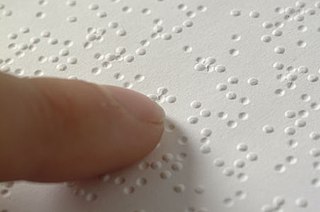| Zambian Braille | |
|---|---|
| Type | alphabet |
| Languages | Bemba, Chewa, Kaonde, Lozi, Lunda, Luvale, Tonga |
Parent systems | Braille
|
Print basis | Bemba alphabet |
Zambian Braille is any of several braille alphabets of Zambia. It has been developed for the languages Bemba, Chewa, Lozi, Kaonde, Lunda, Luvale, and Tonga.

Braille is a tactile writing system used by people who are visually impaired. It is traditionally written with embossed paper. Braille users can read computer screens and other electronic supports using refreshable braille displays. They can write braille with the original slate and stylus or type it on a braille writer, such as a portable braille notetaker or computer that prints with a braille embosser.
The Bemba language, ChiBemba, is a major Bantu language spoken primarily in north-eastern Zambia by the Bemba people and as a lingua franca by about 18 related ethnic groups, including the Bisa people of Mpika and Lake Bangweulu, and to a lesser extent in Katanga in the Democratic Republic of the Congo, Tanzania, and Botswana. Including all its dialects, Bemba is the most spoken indigenous language in Zambia. The Lamba language is closely related and some people consider it a dialect of Bemba.
Chewa, also known as Nyanja, is a language of the Bantu language family. The noun class prefix chi- is used for languages, so the language is usually called Chichewa and Chinyanja. In Malawi, the name was officially changed from Chinyanja to Chichewa in 1968 at the insistence of President Hastings Kamuzu Banda, and this is still the name most commonly used in Malawi today. In Zambia, the language is generally known as Nyanja or Cinyanja/Chinyanja '(language) of the lake'.
It is based on the 26 letters of the basic braille alphabet used for Grade-1 English Braille, so the print digraph ch is written as a digraph ⠉⠓ in braille as well. The letter ñ/ŋ[ŋ] of several of the print alphabets is distinguished from the sequence ng[ŋɡ] with an apostrophe: ⠝⠛⠄ñ, as in the equivalent ng’ of print Bemba. The various alphabets, including digraphs that occur in any one of them, can thus be summarized as:

English Braille, also known as Grade 2 Braille, is the braille alphabet used for English. It consists of 250 or so letters (phonograms), numerals, punctuation, formatting marks, contractions, and abbreviations (logograms). Some English Braille letters, such as ⠡ ⟨ch⟩, correspond to more than one letter in print.
Bemba has the basic alphabet plus ng’, sh, and in some orthographies ch in place of c. Chewa (Nyanja) has ch; Lozi, Lunda and Kaonde have ch, sh, and ñ; Luvale has ch, sh, ph, kh, th; and Tonga has ch, sh, bb, cc, hh, kk, and ŋ.
Numbers and punctuation are as in traditional English Braille.






